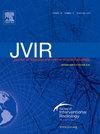In-Stent Restenosis after Carotid Artery Stent Placement Comparing Maximum Plaque Predilation and Postdilation
IF 2.6
3区 医学
Q2 PERIPHERAL VASCULAR DISEASE
Journal of Vascular and Interventional Radiology
Pub Date : 2025-02-01
DOI:10.1016/j.jvir.2024.10.026
引用次数: 0
Abstract
Purpose
To compare the incidence of in-stent restenosis (ISR) and ipsilateral neurologic symptoms in patients treated with maximum plaque dilation before stent deployment (max-pre-D) and stent placement followed by angioplasty (post-D) technical variants of carotid artery stent placement at midterm follow-up.
Materials and Methods
This was a single-center, real-world, retrospective comparative study of 307 patients treated in a single vascular surgery unit between 2014 and 2018. The follow-up protocol consisted of Doppler US performed at 1, 6, and 12 months and annually thereafter. The primary outcome was to compare the incidence of ISR ≥70% in patients treated with post-D and max-pre-D. Secondary outcomes included between-group comparison of the following: (a) symptomatic ISR, (b) reinterventions, and (c) ipsilateral neurologic events.
Results
A total of 270 patients (121 in the max-pre-D group and 149 in the post-D group) fulfilling the inclusion criteria were included in the statistical analysis. Mean follow-up was 30.5 months (SD ± 25.6). The ISR rate was 4.1% (n = 5) in the max-pre-D group and 2.7% (n = 4) in the post-D group, with no significant difference in the survival analysis (log-rank P = .664). Symptomatic ISR and retreatment occurred in 3 patients (33.3% of the total ISR for each outcome). Twenty-one ipsilateral neurologic events occurred, 7 in the max-pre-D group (5.8%) and 14 in the post-D group (9.9%), with no statistically significant difference in survival analysis (log-rank P = .315).
Conclusions
ISR and major neurologic events did not differ significantly between the max-pre-D and post-D groups. Max-pre-D seemed to be as effective as post-D technique in midterm follow-up.

颈动脉支架置入后支架内再狭窄:最大斑块预扩张与后扩张的比较
目的比较中期随访时采用支架置入前最大斑块扩张术(max-pre-D)和支架置入后血管成形术(post-D)技术变体颈动脉支架置入术(CAS)治疗的患者支架内再狭窄(ISR)和同侧神经症状的发生率:单中心、真实世界、回顾性比较研究,对象为2014年至2018年期间在单个血管外科病房接受治疗的307名患者。随访方案包括在1个月、6个月、12个月和之后每年进行一次双工超声检查。主要结果是比较后D和最大前D治疗患者ISR≥70%的发生率。次要结果包括组间比较:i)有症状的 ISR;ii)再干预;iii)同侧神经事件。结果:符合纳入标准的 270 例患者(121 例最大前置 D,149 例后置 D)被纳入统计分析。平均随访时间为 30.5 个月(SD 25.6)。最大D前组的ISR率为4.1%(n=5),D后组的ISR率为2.7%(n=4),生存率分析无显著差异(log-rank p=0.664)。3名患者出现了症状性ISR和再治疗(占各结果ISR总数的33.3%)。发生了21例同侧神经系统事件,最大D前组7例(5.8%),D后组14例(9.9%),生存率分析无统计学差异(log-rank p=0.315):结论:ISR和重大神经事件在最大预D组和后D组之间没有明显差异。在中期随访中,Max-pre-D 似乎与 Post-D 技术一样有效。
本文章由计算机程序翻译,如有差异,请以英文原文为准。
求助全文
约1分钟内获得全文
求助全文
来源期刊
CiteScore
4.30
自引率
10.30%
发文量
942
审稿时长
90 days
期刊介绍:
JVIR, published continuously since 1990, is an international, monthly peer-reviewed interventional radiology journal. As the official journal of the Society of Interventional Radiology, JVIR is the peer-reviewed journal of choice for interventional radiologists, radiologists, cardiologists, vascular surgeons, neurosurgeons, and other clinicians who seek current and reliable information on every aspect of vascular and interventional radiology. Each issue of JVIR covers critical and cutting-edge medical minimally invasive, clinical, basic research, radiological, pathological, and socioeconomic issues of importance to the field.

 求助内容:
求助内容: 应助结果提醒方式:
应助结果提醒方式:


